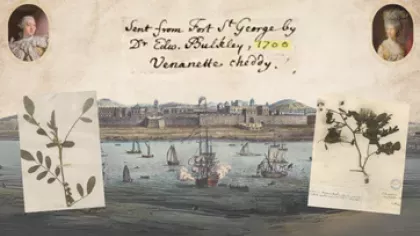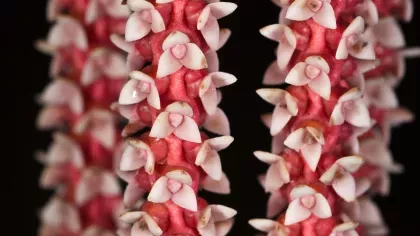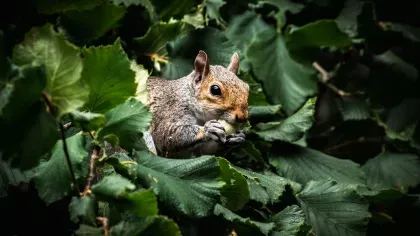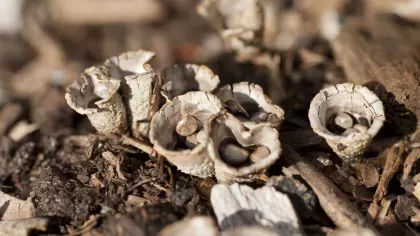1 February 2016
The Lost and Found Fungi project
Brian Douglas describes how the Lost and Found Fungi project at Kew aims to help develop British fungal conservation, by trying to find out which 'lost' species are truly extinct and which species are simply under-recorded due to lack of survey work.

Fungi – a hidden part of our biodiversity
Fungi comprise a significant proportion of the biological diversity on our planet (at least 1.5 million species, but probably around 3 million or more), and they are an intrinsic part of our natural world. Fungi are everywhere, present in all habitats and ecosystems, and engage in complex associations with all plants and probably most other organisms. However, most fungal species are seldom seen, and spend most of their life cycles hidden away as mycelium (networks of fungal hyphae or 'threads') in plants, dead organic matter, soils, and almost any other material you can think of. This can make the true diversity of fungi quite difficult to imagine!
Fortunately, many fungi periodically emerge to reproduce and produce fruit-bodies, which can be more easily seen. If you take the time to stop and look around you, you will soon see how many different types of fungi exist: mushrooms, tooth fungi, coral fungi, puffballs, earthballs, earthstars, earthtongues, spindles, crusts, 'birds’ nest' fungi, cup fungi, rusts, smuts, yeasts, obscure micro-fungi, lichens, and many more! These could be considered the rarely seen 'flowers' of the fungal world, and most are very strange and beautiful.
Fungi have conservation needs, just like plants and animals
Many species of fungi have evolved to inhabit very distinct ecological niches and habitats, and require these to survive. Such niche-specific fungi may be vulnerable to habitat destruction, pollution, and climate change, particularly if restricted to rare host plants or declining habitats. Some species may be genuinely endangered at a national or even global level, clinging on to life at only a small number of sites. If we don’t protect our rarest and most vulnerable fungi, or at least protect the habitats in which they occur, they may become increasingly threatened, perhaps becoming regionally or even globally extinct.
But which fungi are genuinely rare and vulnerable?
Deciding which fungi are genuinely rare and threatened is a major challenge for fungal conservation. Approximately 15,000 species of fungi (at last count) have been recorded in Britain during the past 100+ years, and several thousand species are known only from a few collections or sites. Some have not been reported for over fifty years and may potentially be extinct (or “lost”). The problem is that in most cases we have little idea which species are genuinely rare, which “lost” species are truly extinct, and which species are just under-recorded due to lack of survey work.
Professional and amateur mycologists in Britain have been working on this problem for many years: rediscovering lost species, actively targeting rare species, revisiting sites known from historical records, and surveying plausible locations for new populations. However, if we want to cover the whole of the UK, and investigate the conservation needs of a much larger number of species, we need to greatly increase the number of people actively looking for rarely recorded species. This is where the Lost and Found Fungi project comes in.
The Lost and Found Fungi project
The Lost and Found Fungi project is a five-year volunteer/citizen-science based fungal conservation project coordinated at Kew. It’s funded by the Esmée Fairbairn Foundation, and supported by the British Mycological Society, the British Lichen Society, and many enthusiastic volunteers across the UK.
The project methodology is fairly simple in concept. We’ve compiled a rolling list of 100 species which we think could be among the most threatened fungi in Britain, but which need much more survey work before we can assess their conservation needs with any confidence. We’re asking fungus-recording groups, individual mycologists, botanists, naturalists, and anyone else who might be interested, to engage in a treasure-hunt for these species, either in the sites of historical records near where they live, or in other appropriate habitats.
Fungi can be difficult to find and identify, so we’re providing information on what to look for, when to look, and where to look, in the form of online images, online maps, and downloadable datasheets (see The Lost and Found Fungi project website below). Many of our target species are distinctive enough for most people to recognise, at least when looked for in their specific habitat or on their host plants, and using these online resources. All survey efforts are welcome, whether they result in a find or not, because evidence of unsuccessful searches is essential to demonstrate that a species is genuinely rare.
Together, we’re hoping to significantly improve the baseline data for our target species, produce enough evidence to formally Red List genuinely rare species, and to get their populations and habitats some measure of protection. Equally, we’re hoping to get many more people interested, more knowledgeable, and involved in the conservation of our rarest and most vulnerable fungi. Fungal conservation is important, and we’d like everyone to know that they can help out and get involved!
For more information, please take a look at The Lost and Found Fungi project website or email me, Brian Douglas.
The Lost and Found Fungi Project is funded by the Esmée Fairbairn Foundation, and supported by the British Mycological Society, the British Lichen Society, and many enthusiastic volunteers across the UK.
References
Dahlberg, A., Genney, D. R. & Heilmann-Clausen, J. (2010). Developing a comprehensive strategy for fungal conservation in Europe: current status and future needs. Fungal Ecology, 3(2), pp.50-64. Available online
Hawksworth, D.L. (2012). Global species numbers of fungi: are tropical studies and molecular approaches contributing to a more robust estimate? Biodiversity and Conservation, 21(9), pp.2425-2433. Available online








